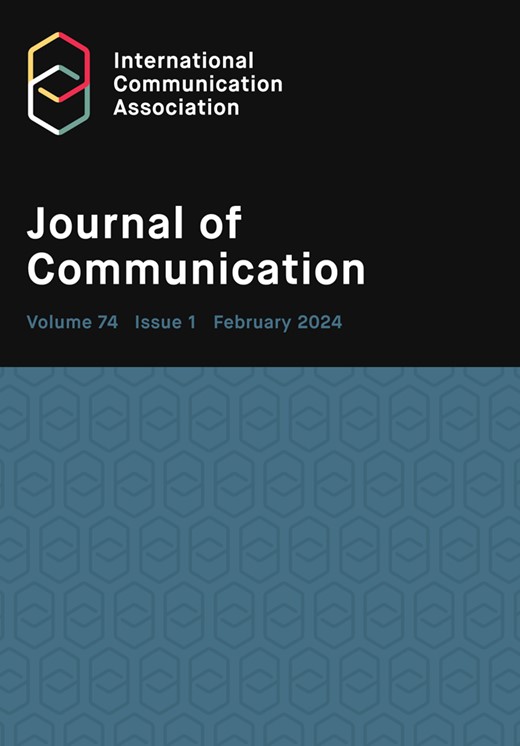通信技术对家庭关系的影响
IF 6.1
1区 文学
Q1 COMMUNICATION
引用次数: 0
摘要
目的:本研究旨在调查通信技术对家庭动态的影响。研究方法:本研究采用案头研究方法。案头研究指的是二手数据或无需实地考察即可收集的数据。案头研究基本上是从现有资源中收集数据,因此,与实地研究相比,案头研究通常被认为是一种低成本技术,因为主要成本涉及执行人员的时间、电话费和目录。因此,本研究依赖于已出版的研究、报告和统计数据。这些二手数据可通过在线期刊和图书馆轻松获取。研究结果:研究结果表明,在通信技术对家庭动态的影响方面存在着背景和方法上的差距。初步的实证审查显示,通信技术对家庭动态产生了深远而复杂的影响,凸显了其好处和挑战。研究发现,技术往往导致面对面互动减少,孤独感增加,对关系满意度产生负面影响,并增加了冲突。父母对技术的使用起到了至关重要的作用,积极的调解和共同观看促进了家庭环境的凝聚力,而青少年过度使用技术则与焦虑和抑郁有关。该研究强调了平衡使用技术的必要性,建议进行开放式交流、制定明确的指导方针以及设立 "无技术 "区,以增进家庭关系和福祉。对理论、实践和政策的独特贡献:社会信息处理理论、家庭系统理论和媒体丰富性理论可用于今后有关通信技术对家庭动态影响的研究。这项研究引入了 "技术偏好 "等概念,并强调了技术使用的社会文化背景,从而为理论知识做出了贡献。它为家庭治疗师和咨询师提供了在家庭中管理技术使用的实用指南,如设定界限和促进面对面的互动。研究还建议政策制定者制定数字扫盲教育计划,鼓励工作场所尊重家庭时间,并与技术公司合作创建支持健康使用技术的功能。此外,研究还强调需要持续的研究资金来探索新兴技术对家庭动态的影响。本文章由计算机程序翻译,如有差异,请以英文原文为准。
The Impact of Communication Technology on Family Dynamics
Purpose: This study sought to investigate the impact of communication technology on family dynamics.
Methodology: The study adopted a desktop research methodology. Desk research refers to secondary data or that which can be collected without fieldwork. Desk research is basically involved in collecting data from existing resources hence it is often considered a low cost technique as compared to field research, as the main cost is involved in executive’s time, telephone charges and directories. Thus, the study relied on already published studies, reports and statistics. This secondary data was easily accessed through the online journals and library.
Findings: The findings reveal that there exists a contextual and methodological gap relating to the impact of communication technology on family dynamics. Preliminary empirical review revealed that communication technology had a profound and complex impact on family dynamics, highlighting both its benefits and challenges. It found that technology often led to decreased face-to-face interactions and increased feelings of isolation, negatively affecting relationship satisfaction and increasing conflicts. Parents' technology use played a crucial role, with active mediation and co-viewing fostering a cohesive family environment, while excessive use by adolescents was linked to anxiety and depression. The study emphasized the need for balanced technology use, recommending open communication, clear guidelines, and "tech-free" zones to enhance family relationships and well-being.
Unique Contribution to Theory, Practice and Policy: The Social Information Processing Theory, Family Systems Theory and Media Richness Theory may be used to anchor future studies on the impact of communication technology on family dynamics. The study contributed to theoretical knowledge by introducing concepts like "technoference" and emphasizing the socio-cultural context of technology use. It provided practical guidelines for family therapists and counselors to manage technology use within families, such as setting boundaries and promoting face-to-face interactions. The study also recommended that policymakers develop educational programs for digital literacy, encourage workplaces to respect family time, and collaborate with technology companies to create features supporting healthy technology use. Additionally, it highlighted the need for ongoing research funding to explore the impact of emerging technologies on family dynamics.
求助全文
通过发布文献求助,成功后即可免费获取论文全文。
去求助
来源期刊

Journal of Communication
COMMUNICATION-
CiteScore
11.60
自引率
5.10%
发文量
41
期刊介绍:
The Journal of Communication, the flagship journal of the International Communication Association, is a vital publication for communication specialists and policymakers alike. Focusing on communication research, practice, policy, and theory, it delivers the latest and most significant findings in communication studies. The journal also includes an extensive book review section and symposia of selected studies on current issues. JoC publishes top-quality scholarship on all aspects of communication, with a particular interest in research that transcends disciplinary and sub-field boundaries.
 求助内容:
求助内容: 应助结果提醒方式:
应助结果提醒方式:


